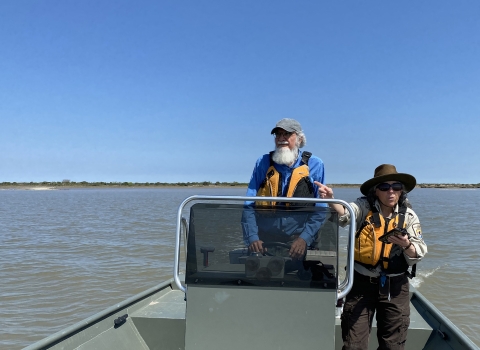The morning felt as though the still air had frozen. In my small backpacking tent, cold air swirled to the roof as I let out the first few breaths of the day. Not a sound was to be heard as morning began in the Sierra Nevada. My frigid body provided me all the motivation I needed to move around in an attempt to thaw myself out. I left my 15-degree sleeping bag’s “warmth” to embrace the fall morning. A ray of sunshine by Rock Creek Lake offered hope to regain feeling in my nose, if it was still attached to my face that is. While waiting to defrost, I wondered...
If these are the mornings that I’m waking up to, what else is in store for these next few days?
It was the beginning of a four-day trip, during which, I would join the California Department of Fish and Wildlife on their Wheeler Ridge surveys for Sierra Nevada bighorn sheep. Little did I know the respect I would gain for the landscape, the animals, and the remarkable biologists who work on this species recovery.
How to find a Sheep
What does it take to survey for bighorn sheep in the rugged Sierra Nevada mountain range? According to Dave German, a Research Specialist for the Department, you need “science-athletes” to do this type of work. California Department of Wildlife biologists spend full days trekking across rugged landscape to count Sierra Nevada bighorn sheep, an endangered subspecies of bighorn sheep, in order to track the size of the year’s herds. These Sierra Nevada bighorn sheep surveys are conducted every year, mostly during the summertime, after the snow has melted away and opened up trails for biologists to backpack to different herd units. It can take multiple days to hike out to, track down, and count the sheep.
Hiking up mountains and looking for bighorn sheep necessitates people who both understand the species and are physically capable of climbing to the 14,000-foot heights where these animals can sometimes be found.
German’s career in conservation spans 23 years. After he left the world of engineering to move to Bishop, California, German started off at the Department as a field technician then used his quantitative skills to become a data analyst. He is a friendly character, eager to answer any questions I had about the species and the local geography, and was kind enough to act as my guide for this day of surveying. We met at a campsite by Dorothy Lake, three miles from the nearest trailhead, and began our quest to find Sierra Nevada bighorn sheep.
Halfway to our destination, German produced what looked like an old school metal antenna from his pack. A metal rod with prongs that stuck out to the sides was assembled in front of me.
*beep*...... *beep*...... beep*
He changes the channel.
*boop*... *boop* ... *boop*
The Department has a number of collared bighorn in each herd. These collars help biologists track and find the other animals in the herd. Each channel has different frequencies that corresponds to each individually collared sheep. German slowly rotates the antenna from side to side as the device attempts to retrieve a signal.
*beep*… *beep* … *beep*…
This signal provides us our bearing and we continue our search.
Life in the Sierras
Sierra Nevada bighorn sheep split off from desert bighorn sheep an estimated 400,000 years ago and adapted to life in the Sierra Nevada.
“These bighorn sheep living in the alpine, are just so tough,” said Tom Stephenson, Sierra bighorn recovery coordinator for the Department. “The way they stick it out on those alpine ridges during storms, it’s one of the most extreme places on the planet. Given the temperatures, the high wind, the amount of snow, the lack of food there, it’s pretty remarkable what those sheep are able to survive.”
Life at 14,000 feet, as Stephenson mentioned, can be brutal. Sub-freezing temperatures, 100+ mph winds, lack of access to food, and massive winter storms that can be followed by the threat of avalanches are just part of what these sheep endure. One helpful adaptation to survive these conditions is the ability to live off of their fat reserves during the winter. By accumulating a healthy amount of fat, the sheep are able to endure long periods of time without access to food.
Another adaptation that shows how clearly these sheep are made for the mountains is in their hooves. Bighorn sheep have soft and cushioned hooves. The bottom of the hoof is similar in texture to that of a rock-climbing shoe. This added traction helps sheep move gracefully across rugged mountain slopes and stand on ledges as narrow as two inches. Their impressive agility in the unforgiving terrain helps to both traverse the land and escape predators.
Made for the Mountains
German and I resumed our hike and he motioned to a point on the mountain, noting that the ridge would be a good area to find sheep. The spot he points to towers above us with no obvious way up. We began a slow trek climbing up a steep path with loose rock underfoot. With every step, rocks shifted and slid around. Progress was steady, but it was slow.
As we trudged up the hill, German stopped to use his spotting telescope. He spied several sheep, around 100 yards further up the slope. I ducked behind a thin grove of trees and, once positioned, I started taking photo after photo.
The sheep are remarkable, their movements are both wandering and intentional. Despite my best efforts to conceal myself, they can clearly see me. However, the sheep had an inquisitive look rather than the fearful look I expected. I later found out from Stephenson that their lack of skittishness is because they know there is no way that I could catch them if I tried. They know they’re safe from me. As if to confirm Stephenson’s point, the sheep migrated across the rocky slope. The loose rock looked like solid ground under their feet. Their movements were graceful as they moved across the rock, and it took them no time at all to travel the same distance that took Dave and I forty minutes to cover. It made my panting and tired legs look like a joke out there. A humble reminder that there is a reason the sheep live here, while I am just a visitor.
From 1000 to 100
“Man is the most dangerous enemy of all, but even from him our brave mountain-dweller has little to fear in the remote solitudes of the High Sierra,” wrote John Muir in his book, The Mountains of California. However, Muir’s presumption of the sheep’s safety from human impacts has proven to be rather optimistic.
The population decline of this species began as Europeans settled the area beginning in the 1800’s. Although exact numbers are unknown, historical bighorn populations likely exceeded 1,000 sheep. Several factors resulted in their decline, including unregulated hunting by settlers, respiratory and other diseases from domestic livestock, especially domestic sheep, and predation, especially by mountain lions. In 1995 there were only about 100 Sierra Nevada bighorn sheep left in the Sierras.
By the 1990’s, a conversation began on how to restore bighorn sheep populations as they continued to decline. Concerned biologists realized that the sheep needed to be protected, otherwise they would be lost. On January 3rd, 2000, the Sierra Nevada bighorn sheep was listed as endangered under the Endangered Species Act. This designation provided federal protection for the species.
Since being listed as endangered, ongoing recovery efforts have helped restore bighorn sheep populations. After years of managing mountains lions, translocating sheep to different herds, reducing exposure to domestic sheep, and consistent surveying, biologists saw optimistic results from all of the recovery efforts. In 2016 it was found that the sheep had a population of more than 600 individuals.
However, the Sierra Nevada is an unforgiving environment. Since the most recent highs of the population surveys, there have been two devastating winters (2016-17, 2022-23) that have taken a toll on the sheep’s population. Threats of avalanches, predation, and lack of access to food were exacerbated by these winters. The intensity of those two years resulted in a decrease in the most recent population estimates, which predict the current population is around 380 sheep.
While the Endangered Species Act has provided the sheep with greater protections, the natural threat of predation, especially by mountain lions, is a serious concern due to the recent relatively low numbers of sheep.
“We’ve had a lot of mountain lion predation in recent years.’’ said Stephenson. “Mountain lion populations go through cycles and right now we appear to be at a high. What’s unfortunate is that during these severe winters, the herds that tend to survive use low elevation winter ranges. This also happens to be where mountain lions are most abundant. And so those lion populations will prey on bighorn sheep,” said Stephenson.
Stephenson also remarked that mountain lion predation is natural, and not normally a threat to the persistence of populations. But with the relatively low population numbers of the sheep, every predatory event takes a greater toll on the specie’s ability to exist on the landscape. The Department is currently managing mountain lions in proximity to Sierra Nevada bighorn sheep until population numbers increase enough that they can withstand normal levels of predation.
“What I would like for people to understand is that that conservation is not linear,” said Stephenson. “There are a lot of challenges to recovering a species, and we are learning new things every day about what it requires to restore an animal on this landscape.”
The Roof of the World
The day after my excursion with German, I joined Stephenson on his surveying route up Mt. Morgan, a near 14,000-foot peak. He talked about the challenges to recovery, lessons learned, and the amount of human power it takes to survey the sheep. I learned that nearly the entire summer is spent hiking to different herds in the Sierra Nevada to count sheep. One herd even took two days worth of hiking to reach, not including the amount of time it takes to survey. In addition to the hiking, the surveying team also had to watch out for summer thunderstorms, which made for dicey weather conditions.
Once Stephenson and I reached our destination, he went on to a specific point to scan for sheep. I briefly departed his company to climb to the peak. Once at the top of the mountain, I scanned my surroundings. At 13,748 feet, there was clear evidence of sheep. Bed sites in the tallus revealed the presence of bighorn at the very peaks of where they lived. It brought a smile to my face to think that they too enjoyed the view from the roof of the Sierra Nevada.
After a short period, I saw Stephenson packing up, and I made my way down to join him. An all-day hike for a brief look for sheep. After we walked back for a bit, Stephenson mentioned another surveying opportunity for me to join. “Well, we go out looking for sheep in the winter too, it would be great if you could join us and get some winter photos.” He paused, “Do you know how to ski in the backcountry?”









